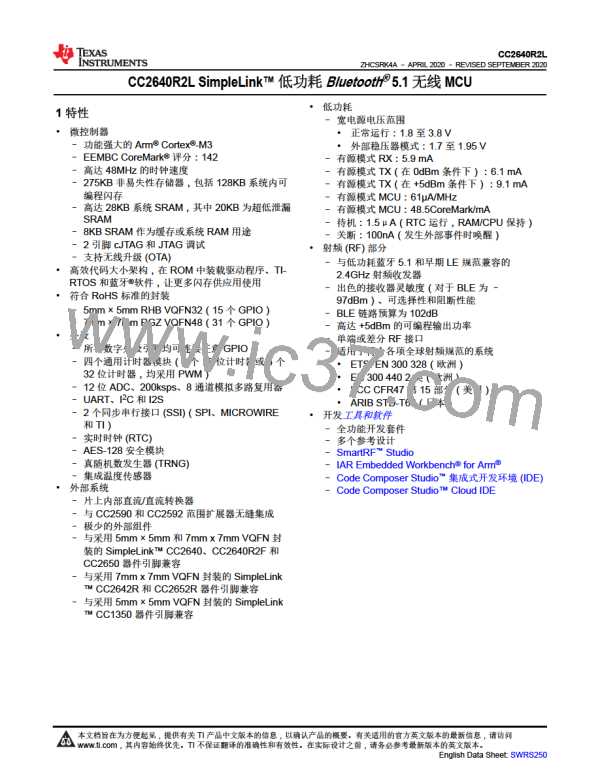CC2640R2L
ZHCSRK4A –APRIL 2020 –REVISED SEPTEMBER 2020
www.ti.com.cn
Measured on the TI CC2650EM-5XD reference design with Tc = 25°C, VDDS = 3.0 V, fRF = 2440 MHz, unless otherwise
noted.
PARAMETER
TEST CONDITIONS
MIN
TYP
MAX UNIT
Blocker rejection, ±8 MHz and
above(1)
Wanted signal at –79 dBm, modulated interferer at
>46
dB
±8 MHz and above, BER = 10–3
Out-of-band blocking (3)
Out-of-band blocking
Out-of-band blocking
30 MHz to 2000 MHz
2003 MHz to 2399 MHz
2484 MHz to 2997 MHz
dBm
dBm
dBm
–40
–19
–22
Wanted signal at 2402 MHz, –76 dBm. Two
interferers at 2405 and 2408 MHz respectively, at the
given power level
Intermodulation
dBm
–42
(1) Numbers given as I/C dB.
(2) X / Y, where X is +N MHz and Y is –N MHz.
(3) Excluding one exception at Fwanted / 2, per Bluetooth Specification.
8.7 125-kbps Coded (Bluetooth 5) –TX
Measured on the TI CC2650EM-5XD reference design with Tc = 25°C, VDDS = 3.0 V, fRF = 2440 MHz, unless otherwise
noted.
PARAMETER
TEST CONDITIONS
MIN
TYP
MAX UNIT
Differential mode, delivered to a single-ended 50-Ωload
through a balun
Output power, highest setting
5
dBm
Measured on CC2650EM-4XS, delivered to a single-ended
50-Ωload
Output power, highest setting
Output power, lowest setting
2
dBm
dBm
dBm
dBm
dBm
dBm
Delivered to a single-ended 50-Ωload through a balun
f < 1 GHz, outside restricted bands
f < 1 GHz, restricted bands ETSI
–21
–43
–65
–71
–46
Spurious emission conducted
measurement(1)
f < 1 GHz, restricted bands FCC
f > 1 GHz, including harmonics
(1) Suitable for systems targeting compliance with worldwide radio-frequency regulations ETSI EN 300 328 and EN 300 440 Class 2
(Europe), FCC CFR47 Part 15 (US), and ARIB STD-T66 (Japan).
8.8 500-kbps Coded (Bluetooth 5) –RX
Measured on the TI CC2650EM-5XD reference design with Tc = 25°C, VDDS = 3.0 V, fRF = 2440 MHz, unless otherwise
noted.
PARAMETER
TEST CONDITIONS
MIN
TYP
MAX UNIT
Differential mode. Measured at the CC2650EM-5XD
SMA connector, BER = 10–3
Receiver sensitivity
dBm
–101
Differential mode. Measured at the CC2650EM-5XD
SMA connector, BER = 10–3
Receiver saturation
>5
dBm
240 kHz
500 ppm
330 ppm
dB
Difference between the incoming carrier frequency
and the internally generated carrier frequency
Frequency error tolerance
Data rate error tolerance
Data rate error tolerance
Co-channel rejection (1)
Selectivity, ±1 MHz (1)
–240
–500
–310
Difference between incoming data rate and the
internally generated data rate (37-byte packets)
Difference between incoming data rate and the
internally generated data rate (255-byte packets)
Wanted signal at –72 dBm, modulated interferer in
–5
9 / 5(2)
channel, BER = 10–3
Wanted signal at –72 dBm, modulated interferer at
dB
±1 MHz, BER = 10–3
Wanted signal at –72 dBm, modulated interferer at
±2 MHz, Image frequency is at –2 MHz, BER = 10–3
Selectivity, ±2 MHz (1)
41 / 31(2)
dB
Copyright © 2023 Texas Instruments Incorporated
14
Submit Document Feedback

 TI [ TEXAS INSTRUMENTS ]
TI [ TEXAS INSTRUMENTS ]